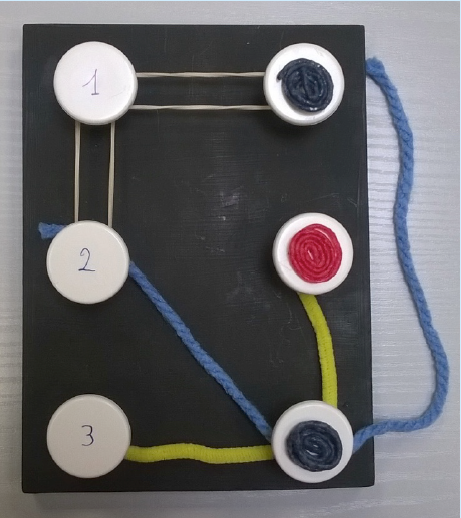
Resource
Let’s Play With The Six Dot Cell
Presentation of teaching pre-braille skills and a new model in France.
Marc Angelier, Teacher of the Visually Impaired
Marie Oddoux, Occupational Therapist
In April 2017, we were in Stockholm for the first Tactile Reading Conference and are sharing our presentation here.
Why a prebraille project?
Report:
- Young blind children are not well prepared for school. Regular French schools are not well prepared for blind children.
- Tactile books are rare and expensive.
- Toys, games, and school activities need too much adaptation.
- No special school curriculum
- Regular class teachers don’t really know what to do with students who are blind.
- We only get to see the students once or twice a week, and of course it is not enough.
OT & TVI Goals:
- Increase desire for reading
- Develop tactile and compensatory skills
- Develop fine and gross motor skills
- Develop cognitive skills
- As a matter of fact: Prebraille Skills
French national preschool curriculum:
- Preschool starts at 4 years old and lasts for 3 years
- A new curriculum started in September 2016
- A new way to introduce concepts using discovery, manipulation, sensory, body and language developments
Unique Collaborative Curriculum:
347 GOALS
4 categories:
- Green: No particular adaptation
- Blue: Not applicable
- Orange: Literacy
- Red: With the 6 Dots Cell Method
“Let’s play with the 6 dots cell”
Who is this method for?
- Adults in charge of blind children:
- Parents
- Day care staff
- Regular teachers
- Teachers of the visually impaired
- Occupational therapists
What’s in it?
Material aspect:
- List of tools and materials
- Manufacturing instructions
- List of small equipment to carry out the proposed activities
Pedagogical aspect:
- Pre-braille skills
- Preschool and kindergarten skills
- Activities
- Evaluation form
5 Categories:
Decreasing size of the cell = Progression by age
Body Braille:
Large Cell:
Medium Cell:
Small Cell:
Regular Braille:
Peg Cell:
Adapted activities according to FNCP goals:
Examples of goals:
- Place an element knowing its position and respect the direction of the course.
- Use spatial expressions, especially those based on opposites: on / under, in / out, next to / away from …
- Make a construction by having a reference model that the child can manipulate or observe.
Using different materials and textures
Using one or several cells
Using different spatial planes with a box, a wall…
Using various types of representation of cells: 3D, 2D, raised cell on paper
Using writing and reading modes going from one to the other (swing cell)
Conclusion
Visually impaired child can do 95.4% of the preschool skills!
PBresults reach
Inclusion is facilitated!
Thanks to:
In France:
- Nathalie Lewi-Dumont and Michele Collat
In Canada:
- Louis Comtois and Lise Semard (Fondation des Aveugles du Quebec)
- Eve Bedard and Helene Berthiaume (Ecole Jacques-Ouellette)
- Stephanie Desjardins (MAC-Mackay)
- Maude Demers-Bonin (INLB)
- Isabelle Grant (Commission scolaire des premieres-seigneuries)
- Danielle Bouchard (IRDPQ)
In the USA:
- Mary McCarthy (Perkins School for the Blind)
- Karen Frank and Deb Nikkila (Maryland School for the Blind)
- Jennifer Eaton (Vision Corps)
- Sister Lisa, Christine Geiger, and Kathy Cleaver (St. Lucy Day School)
- Mary Daubenspeck and Marianne Smith (CAIU)
- Edie Goldman and Dawn Bridget (The New York Institute for Special Education)
- Nancy Doyle (Lighthouse Guild)
- Teresa Doan (Arkansas School for the Blind)
- Suzette Wright, Dawn Wilkinson, Kathie Senft-Graves (APH)
- Kathy Mullen (VIPS)
- Cyral Miller, Laura Miller (Texas School for the Blind)
- Marielena Rivas (TLC4Blind)
- Fernanda Armenta-Schmitt (Blind Children’s Center)
- The Braille Institute
And a special thank you to Sue Dwyer.
Contact: readyforprebraille@gmail.com





















